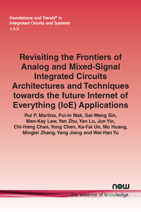Revisiting the Frontiers of Analog and Mixed-Signal Integrated Circuits Architectures and Techniques towards the future Internet of Everything (IoE) Applications
Rui P. Martins, University of Macau, China, rmartins@um.edu.mo , Pui-In Mak, University of Macau, China, Sai-Weng Sin, University of Macau, China, Man-Kay Law, University of Macau, China, Yan Zhu, University of Macau, China, Yan Lu, University of Macau, China, Jun Yin, University of Macau, China, Chi-Hang Chan, University of Macau, China, Yong Chen, University of Macau, China, Ka-Fai Un, University of Macau, China, Mo Huang, University of Macau, China, Minglei Zhang, University of Macau, China, Yang Jiang, University of Macau, China, Wei-Han Yu, University of Macau, ChinaAbstract
People-to-people (P2P) technology-assisted interconnections, embedded in a global environment, will be at the core of 21st century communications and will command the technological development of the future. The Internet-of-Things (IoT) comprises only machine-to-machine (M2M) communications handling only data and things. Expanding itself beyond IoT, the Internet-of-Everything (IoE) also incorporates intelligently the interaction of people and process (providing at a precise moment the correct knowledge to the exact person/machine).
In general, IoT comprises all physical or cyber objects (things) with an address that can transmit information without human-to-machine interactions (data), while the IoE also involves communications (processing) among the users (people) and the whole universe of electronic gadgets. Further, they both operate with data acquired from analog sources, thus connecting two different realities, the analog (physical/real) and the digital (cyber/virtual) worlds. Since the interface between the two realms deals with analog signals, its mandatory functions involve sensing, measuring, filtering, converting, processing, and connecting, with the accuracy and precision of the analog layer ruling the entire system. Such interface integrates several analog and mixed-signal subsystems that include signal sensing, transmission and reception, frequency generation, energy harvesting (EH), in-memory processing, and data and power conversion.
This paper presents state-of-the-art designs of the most critical building blocks of the analog/digital interface highlighting new and innovative circuit architectures and techniques. It addresses capacitive sensor interfaces, ultra-low-power wireless transceivers, key technologies for wireline transceivers, oscillators and frequency generators, integrated energy harvesting (EH) interfaces, in-memory processing, as well as, data and power converters, all exhibiting high-quality performance with low power consumption, high energy-efficiency and high speed, thus enabling a reliable and consistent development of the IoE while enlarging its frontiers.
Revisiting the Frontiers of Analog and Mixed-Signal Integrated Circuits Architectures and Techniques towards the future Internet of Everything (IoE) Applications
Technology-assisted People-to-People (P2P) interactions, embedded in a global environment, will be at the core of 21st century communications and will command the technological development of the forthcoming future. The intelligent interactivity of people, process (delivering the right information to the right person/machine at the right time), data and things, incorporates the Internet-of-Everything (IoE) that expands itself beyond the Internet-of-Things (IoT). In general, IoT comprises all physical or cyber objects (things) with an address that can transmit data (without human-to-machine interactions), while the IoE also involves communications among the users and the whole universe of electronic gadgets. Further, they both operate with data acquired from analog sources, thus connecting two different realities, the analog (physical/real) and the digital (cyber/virtual) worlds. Since the interface between the two realms deals with analog signals, its mandatory functions integrate several analog and mixed-signal sub-systems that include signal sensing, transmission and reception, frequency generation, energy harvesting, in-memory processing, data and power conversion.
This publication presents state-of-the-art designs of the most critical building blocks of the analog/digital interface highlighting new and innovative circuit architectures and techniques. It addresses capacitive sensor interfaces, ultra-low-power wireless transceivers, key technologies for wireline transceivers, oscillators and frequency generators, integrated energy harvesting interfaces, in-memory processing, as well as, data and power converters, all exhibiting high quality performance with low power consumption, high energy-efficiency and high speed, thus enabling a reliable and consistent development of the IoE while enlarging its frontiers.
In the coming decades, with the continuous evolution of electronics downscaling, the challenges that the above-mentioned sub-systems face will be tremendous in terms of the requirements for ultra-low power and ultra-high speed, obtained with the maximum energy-efficiency. Thus, the analog and mixed-signal very large scale integration area of work will continue to be an attractive field for research for design engineers both in the academia and in the industry, as it has been always the case since the emergence of silicon planar electronics 6 decades ago.
